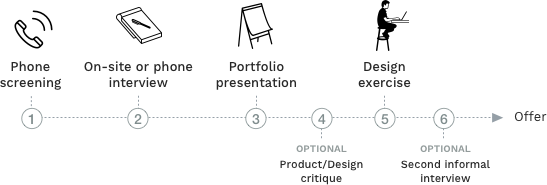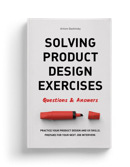Cracking The UX Design Job Interview in 2023
I mapped out the product and UX design interviews process at tech companies based on the research I’ve done while writing my book “Solving Product Design Exercises: Interview Questions & Answers”. I gathered the best resources you should use to prepare for each step.
The hiring process is different at every company, but here is the general structure that most of tech companies use for hiring UX and product designers:

1. Phone screening
The call usually takes between 10-20 minutes and is done by a recruiter or HR person. The main goal of this call is to understand if there is a basic match between you and the hiring company. They’ll explain in more depth about the position and ask about your current employment status, past experience and what you, as the candidate, are currently looking for in the role.
Some of the questions that could be asked in this call:
- Why are you interested in [Company]?
- Why are you interested in this position?
- What are you looking for in your next position?
- Why did you join and leave your last three positions?
- What is your experience with X? (It could be a relevant skill, technology, tool or platform company that are relevant for the company, e.g. "What is your experience with designing a second-screen experience/wearables/TVs?")
You also may get asked more technical qustions like:
- What is your legal status and do you need our company to help you with your working visa?
- What are you preferences regarding remote/on-site work?
- What is the notice term you need if you were hired?
- What is your salary expectation?
Take advantage of this call to practice "pitching" yourself as a great candidate. If you're looking for a job you might have a few of such calls, so even if some of them don't go well, try to learn from it and improve for the next one.
2. On-site or phone interview
This step is a deep-dive into your process, tools and dynamics with teams you've worked with. Usually this interview also includes situational questions like: tell me about a time when you...
- ...took on something significant outside your area of responsibility (asked at Amazon)
- ...disagreed with a team member
- ...disagreed with a business goal and how you handled it
- ...couldn't solve a problem (asked at Google)
Some other questions asked at UX design job interviews:
- How did you become a designer?
- What is your design process?
- What project are you especially proud of and why?
- Describe your dream job.
- Provide an overview of the tools you regularly use in your work.
- What are some examples of a great user experience that has impressed you and why?
- What motivates you most?
Many designers I spoke with during my research said that they are intimidated by behavioural questions. Luckily, they aren't unique to design interviews, so there is a lot of content available on how to handle them well. My main advice is to prepare for these questions in advance. This is a great resource to start: Top Job Interview Questions and Best Answers.
For more design-specific questions, Ian Schoen (Senior Product Designer at SalesForce) made a list of crucial questions he was asked during his job search. Based on his experience of more than 40 coffee dates, phone calls, design presentations and one-on-one interviews: 10 questions you’ll be asked in a UX interview.
Facebook have a well-structured and well-performing hiring process. In the hiring process their recruiters recommend to go through articles that prepare candidates for the interviews. In my opinion it only indicates that designers aren't making enough efforts to prepare for interviews, so in case you do, it will be a great competitive advantage (not just at Facebook). Here are some of the articles Facebook recruiters recommend: How to impress interviewer, 7 Reasons to No-Hire a Product Designer, Part 2, Part 3.
This step also the time when more details about the position are discussed. Remember that you also expected and should ask questions as well. Prepare questions for your interviewer, based on values that are important for you in the job (personal health, career growth, team values etc.): The perfect questions to ask in your job interview.
3. Portfolio presentation
Portfolio review can be combined with the previous step. Sometimes candidates are asked to present their work to the design or product lead or to a broader team of three to five people. You are expected to walk the audience through your projects, explain the objective, how you contributed, what decisions you took and why.
An article that will help you prepare: Get any UX job with a stellar portfolio presentation by reading this.
I've also assembled a bundle of materials to help you create a stronger portfolio. It is based on an analysis of 283 portfolios of designers who have landed jobs at Google, Amazon, Microsoft, Shopify, Meta, and Dropbox.
4. (optional) Product/Design critique
Sometimes, as a part of skills evaluation, a candidate is asked to critique a certain product’s design. You may be asked what works, what doesn’t, how could it be improved, why the company built this feature etc: How to do a Product Critique.
5. Design exercise
This is a key step in the process that heavily influences hiring decisions. Candidates are asked to solve a product design problem and explain their decisions behind the solution. I wrote a book that explains exactly how to prepare for the exercise and perfect it: Solving Product Design Exercises: Interview Questions & Answers.
This book also provides a framework that could be used for the design critique and portfolio review.
6. (optional) Second informal interview
Sometimes second informal interview is done to test the company’s concerns before issuing an offer i.e. cultural fit, specific aspects of your experience or skills that are lacking.
Offer
In case you're being interviewed for a job at startup, I really recommend to understand well how equity works and what should you expect from it: What I Wish I'd Known About Equity Before Joining A Unicorn.
To learn more about UX design job interviews check out the interview I gave to Harry Ford.

Prepare for your next UX job interview
A highly practical book for practicing take-home or whiteboard design challenges and portfolio presentation.
